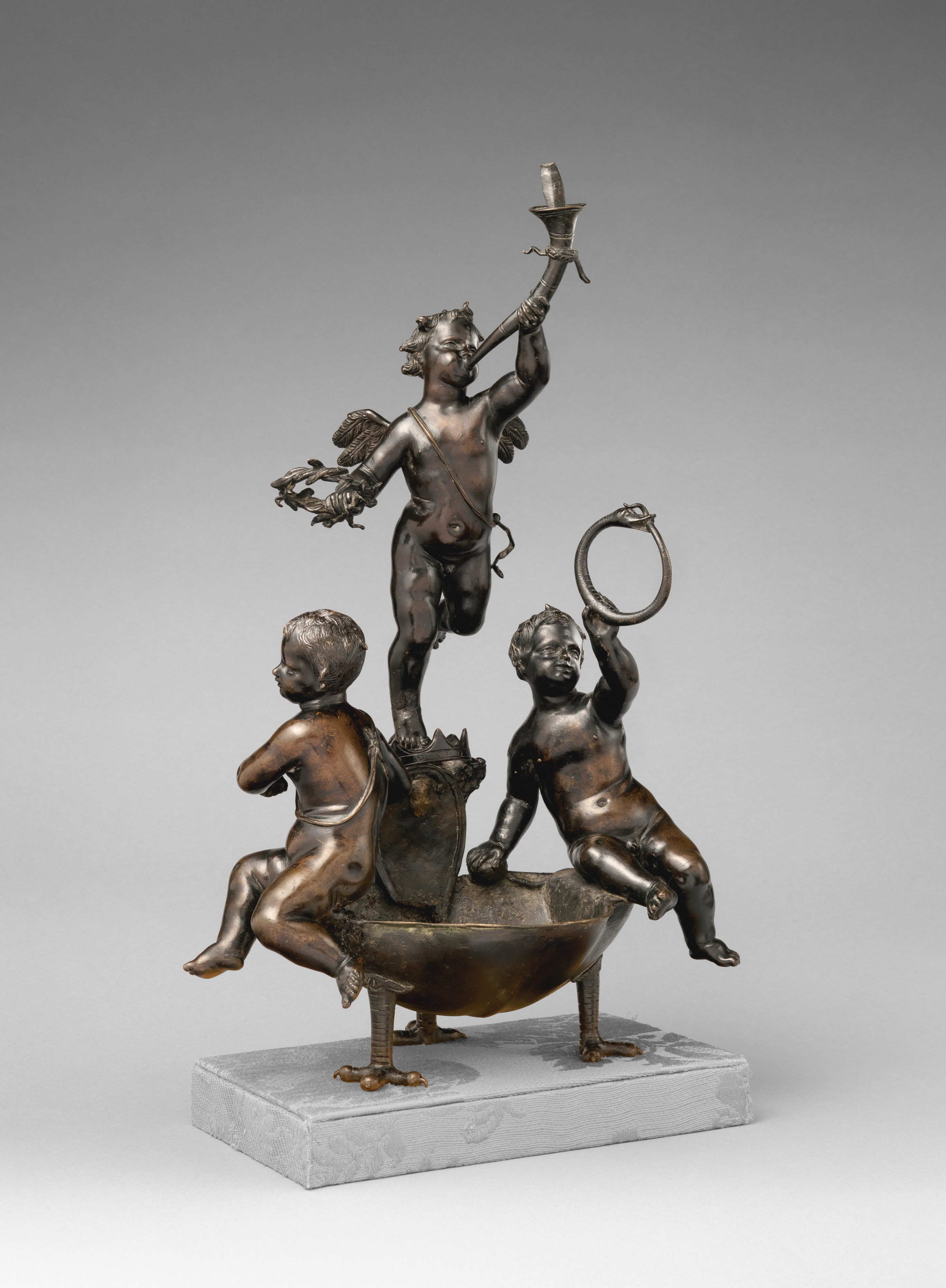Inkwell with three putti
Francesco Bertos Italian
Three nude putti surmount a trilobed shell-basin supported on three legs shaped like bird’s claws. The central figure rises above a crowned escutcheon whose coat of arms and lower point are missing. The escutcheon is backed by a military trophy of club, arrow, and ax, and it ends on a broken extension and two squared hooks. The child it supports blasts a beribboned trumpet from which a broken flame emerges. Carrying a laurel wreath and sporting a ribbon-sash, he embodies Fame. The child perched precariously on the left, also sashed, points to an open book with the legend incised in degraded Latin: Virtus/in/puetio/non est. If puetio is a contraction of pueritia, the sense should be a play on the infantine imagery to the effect that “childish things do not produce virtue” or “virtue does not reside in puerility,” although Charles Avery translates it as “Virtue lies not in price.”[1] The boy to the right sits more securely on the rim and brandishes a circlet framing a serpent biting its own tail, an old symbol of Eternity. A strong breeze is implied in the whipped-up peaks of the boys’ stringy hair. Despite losses, the piece retains much of its dark patina.
Headquartered in Padua, Francesco Bertos supplied a large clientele there and in Venice, as well as patricians in nearby villas along the Brenta. One of the most generous and enthusiastic was Johann Matthias von der Schulenburg, a German field marshal retired from the service of the Serenissima and an important collector of Venetian art, notably paintings by Giovanni Battista Piazzetta.[2] Avery presents an attractive theory that our vessel was made for Schulenburg.[3] Besides large groups, beginning in 1732 the marshal bought a few small bronzes from Bertos, described as “an inkwell,” “a paperweight,” and “the little group of bronze of three puttini.” Bertos received a small payment of five zecchini and eleven lire for the inkwell and paperweight on August 25, 1738.[4] The inkwell, “a little group of bronze,” and “three little groups of bronze” were valued together at 230 thalers in a Schulenburg inventory of June 30, 1741.[5]
The “little group of bronze of three puttini” could have been any of these. Avery notes that our three boys are easily interpreted as emblems of military glory, and that the “rather stiff-looking” three-taloned bird’s feet that support the bowl are very similar to those of the shield at the center of Schulenburg’s armorial bearings, concluding that the missing arms were very likely those of the marshal.[6] The object probably functioned as a fancy inkwell. The small square projections behind the shield may have served as hooks upon which to rest a pen. Avery’s alternative, that the vessel is a sweetmeat dish whose hooks could have suspended spoons, makes less sense in view of the object’s military overtones and Schulenburg’s dignity.
-JDD
Footnotes
(For key to shortened references see bibliography in Allen, Italian Renaissance and Baroque Bronzes in The Metropolitan Museum of Art. NY: The Metropolitan Museum of Art, 2022.)
1. C. Avery 2008, p. 257.
2. See Binion 1990.
3. C. Avery 2008, pp. 19, 257.
4. Binion 1990, p. 162, also p. 190 for an inventory of May 30, 1738, in which the “three other smaller groups are listed but not yet the inkwell and paperweight because they had not yet been contracted for.” See also ibid., p. 271, seventh shipment of works to Berlin, listing “little groups of bronze of three puttini.”
5. C. Avery 2008, p. 23 n. 34, cites Niedersächsisches Hauptstaatsarchiv Dep. 82, III, no. 37, for the three groups valued together at 150 zecchini. Schulenburg also had an “Ecritoire de bronze” by Bertos; ibid., p. 23 n. 36.
6. Ibid., p. 19, fig. 8A, illustrates the Schulenburg arms. Crowned shields occur on similar vessels with babies in ibid., pp. 260–61, nos. 191 and 192, called salts.
Due to rights restrictions, this image cannot be enlarged, viewed at full screen, or downloaded.
This artwork is meant to be viewed from right to left. Scroll left to view more.



